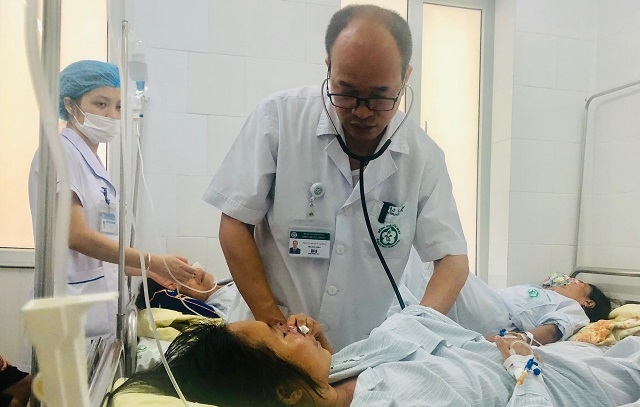 Society
Society

Cases of Whitmore’s disease, also called melioidosis, has increased remarkably during the rainy season with a high rate of mortality, director of the National Hospital of Tropical Diseases Đỗ Duy Cường said.

|
| Director of the National Hospital of Tropical Diseases Đỗ Duy Cường checks patients infected with Whitmore's Disease at the National Hospital of Tropical Diseases. Photo nhandan.com.vn |
HÀ NỘI Cases of Whitmore’s disease, also called melioidosis, has increased remarkably during the rainy season with a high rate of mortality, director of the National Hospital of Tropical Diseases Đỗ Duy Cường said.
In August alone, at least 12 people have been hospitalised with Whitmore’s disease at Hà Nội-based Bạch Mai Hospital and the National Hospital of Tropical Diseases. Of those, four of the patients died.
This year, 20 cases have been reported. This number is equal to those reported over the last ten years.
Cường said Whitmore’s disease was a dangerous acute infectious disease caused by a bacterium called Burkholderia pseudomallei.
The bacteria exist in contaminated water and soil. Transmission to humans and animals is through skin contact with the contaminated source or the inhalation of particles containing the bacteria.
As many as 16 cases of Whitmore’s disease were reported in July and August at the hospital. Of those, 12 patients were in critical conditions.
Cường said the rainy season provided good conditions for the development of the virus. The disease has a high mortality rate of approximately 40 per cent if the patient is misdiagnosed and does not receive proper treatment.
According to the doctor this is a serious infection that causes damage to many organs. Patients suffering from diabetes or chronic lung, heart, or kidney-related diseases are vulnerable to the virus. These patients may suffer multiple organ failure and death if infected.
Cường said the doctors had prescribed high-dose antibiotics for these patients and received consultations from specialists, but some patients had severe liver damage and respiratory failure that could not be cured.
The Bạch Mai Hospital’s Department of Infectious Diseases received a patient suffering from a severe abscess on her nose.
She was misdiagnosed as having sepsis caused by a staph infection at a local hospital.
The doctors had to completely change the treatment regimen, otherwise the patient could have died. The patient would be given a combination of antibiotics for at least three months under strict monitoring to avoid relapse, he said.
Cường said the disease had a wide range of symptoms that could be misdiagnosed for other diseases. Many patients were diagnosed with sepsis caused by staph infections. Tuberculosis and pneumonia were also blamed as the cause of the symptoms.
Currently, there is no vaccine for the disease.
Cường said it was necessary to improve the training of microbiologists at grassroots-level hospitals, so that patients can be treated properly. VNS




